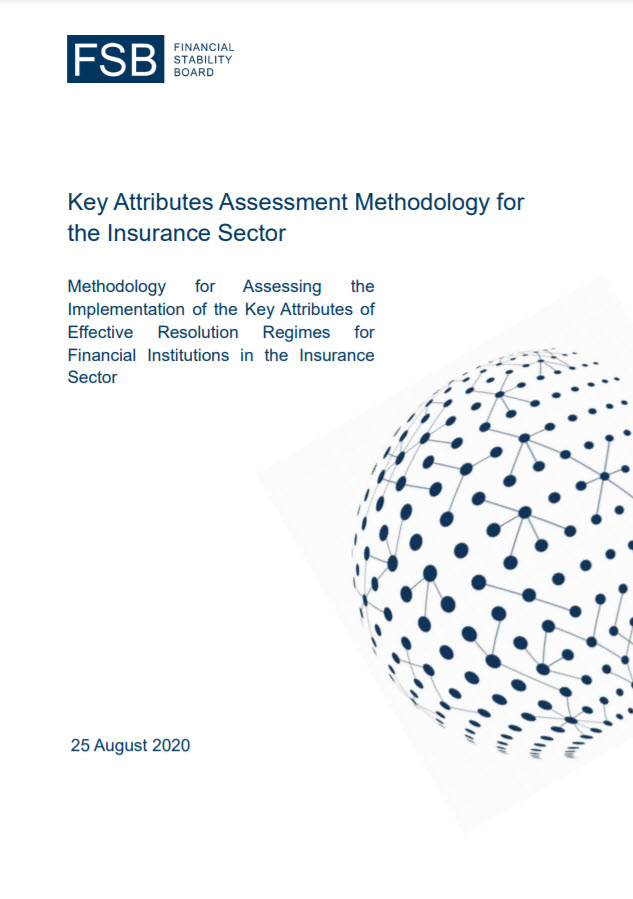Crisis Management and Resolution
The FSB Key Attributes of Effective Resolution Regimes for Financial Institutions (KAs) are the international standard for resolution regimes. The FSB has developed guidance on how to apply the standard across sectors. It also published methodologies for assessing their implementation. The FSB monitors implementation across sectors and jurisdictions and reports progress in its annual resolution report.
The twelve Key Attributes
General and sector-specific standards, guidance and reports
Select a sector from menu to see more.
| Related KA | Guidance and Reports | |
|---|---|---|
| All | Depositor Behaviour and Interest Rate and Liquidity Risks in the Financial System: Lessons from the March 2023 banking turmoil (October 2024) | |
| All | 2023 Bank Failures: Preliminary lessons learnt for resolution (October 2023) | |
| All | Lessons learnt from the COVID-19 pandemic from a financial stability perspective: Final report (October 2023) | |
| KA 3, 11 | Historical Losses and Recapitalisation Needs: Findings report (November 2015) | |
| KA 4 | Temporary Stays on Early Termination Rights (October 2011) | |
| KA 7, 12 | Information sharing for Resolution Purposes (November 2014) | |
| KA 8, 9, 11 | Guidance on Cooperation and Information Sharing with Host Authorities of Jurisdictions where a G-SIFI has a Systemic Presence that are Not Represented on its CMG (November 2015) | |
| KA 9 | Institution-specific Cross-border Cooperation Agreements (October 2011) | |
| KA 10 | Resolvability Assessments (October 2011) | |
| KA 11 | Essential Elements of Recovery and Resolution Plans (October 2011) | |
| Related KA | Guidance and Reports | |
|---|---|---|
| KA 1, 2, 3, 5, 6, 8, 9, 10, 11, 12 | Resolution of Insurers (November 2014) | |
| KA 3, 11 | Internal Interconnectedness in Resolution Planning for Insurers: Practices Paper (January 2022) | |
| KA 11 | Identification of Critical Functions of Insurers: Practices paper (November 2023) | |
| KA 6 | Resolution Funding for Insurers: Practices Paper (January 2022) | |
| KA 6, 8, 9, 10, 11, 12 | Developing Effective Resolution Strategies and Plans for Systemically Important Insurers (June 2016) | |
| Related KA | Guidance and Reports | |
|---|---|---|
| KA 1, 2, 3, 4, 6, 7, 10, 11, and 12 | Protection of Client Assets in Resolution (November 2014) | |
Annual Resolution Reports
Annual resolution report outlines the implementation of resolution reforms and discusses the work accomplished by the FSB over the past year and anticipated work in 2025.
15 December 2023
Annual report on implementation of resolution reforms takes stock of progress in making financial institutions resolvable.
Annual report on implementation of resolution reforms.
7 December 2021
Annual report on implementation of resolution reforms.
18 November 2020
Annual report on implementation of resolution reforms.
14 November 2019
Annual report on implementation of resolution reforms.
15 November 2018
Annual report on the implementation of the reforms to help end “too-big-to-fail“”.
Sixth report on resolution reforms.
FSB’s fifth report to the G20 on progress in resolution including details on the Resolvability Assessment Process.
9 November 2015
The progress report provides an update on the FSB’s work to develop policy to allow for recovery and resolution of SIFIs.
12 November 2014
This report finds continuing, though incomplete, progress in the reform of resolution regimes and resolution planning and identifies areas where further work is needed.
2 September 2013
This report sets out the next steps for completing the policy measures and end the “Too Big To Fail” problem.
An update on the reforms initiated by jurisdictions to align national resolution regimes and institutional frameworks with the Key Attributes.





